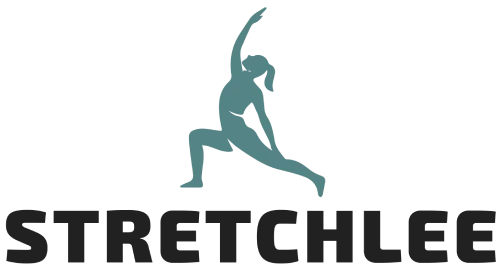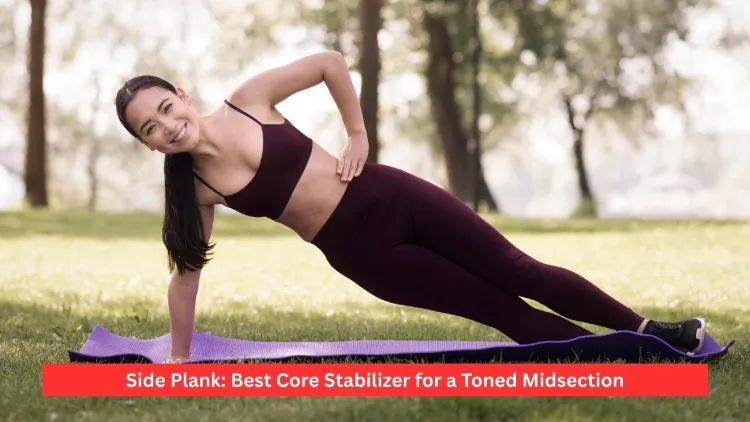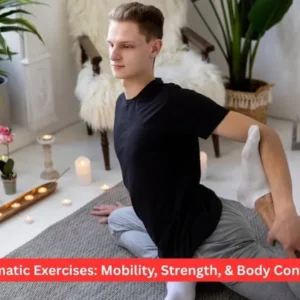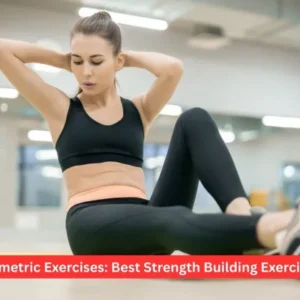The side plank is one of the most useful bodyweight exercises that mainly trains the obliques, which is useful in developing core strength, balance, and stability. It enhances posture, lessens lower back pain, slims down the waistline and may result in a flatter stomach in conjunction with a healthy lifestyle. The side plank has variations that can be based on beginners and experienced persons, so that you can use them daily to achieve results within a few weeks. Illustrated in the figure above, the product is ideal as people wish to reduce their waist, get fit, or even create stability in the entire body.
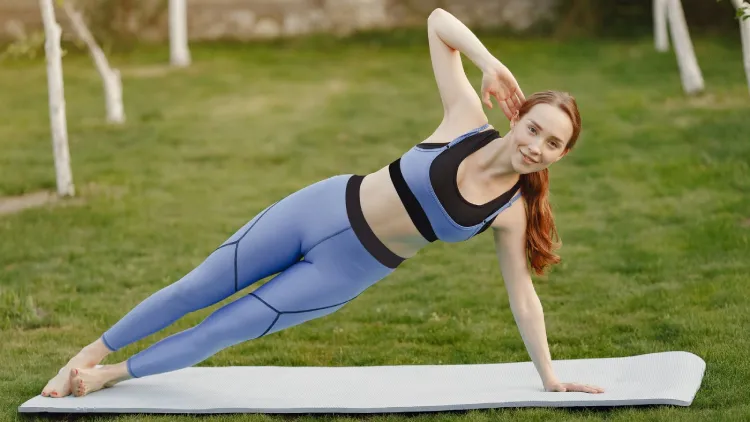
- What is a Side Plank?
- Muscles Worked in Side Plank
- Advantages of Doing Side Planks
- How to Master a Side Plank
- Side Plank Variations at Both Levels
- Most Popular Side Plank Errors to Avoid
- Side Plank Workout Routine
- Who Should Do Side Planks?
- Benefits of Side Planks (Long-term)
- Final Thoughts
- Frequently Asked Questions
What is a Side Plank?
Side plank is an exercise that strengthens the core, and it is done by placing the body on an arm and the side of one foot, keeping the body straight. The trick to a successful plank is keeping your body straight, engaging your obliques and fighting the force of gravity as your core muscles perform their work to ensure that your body does not fall face-first.
The side plank is a stationary exercise; a type of isometric exercise which is the one that does not require any muscle to lengthen or shorten. Such a stationary position develops the muscular endurance as well as deep core stability that are important in daily movement, sports activity, and injury avoidance.
Muscles Worked in Side Plank
Side plank is a good workout that involves the full core and involves:
- Obliques: The main muscle group is a set of muscles that help us hold our bodies in place on a lateral plane.
- Rectus Abdominis: The purpose of this muscle is to support the core and to flatten the stomach.
- Transverse Abdominis: Postural and abdominal stabiliser.
- Quadratus Lumborum: This is the lower back muscle, which prevents a bend on one side.
- Gluteus Medius and Minimus: Stabilisers of the hip that make the lower body balanced.
- Shoulders and Triceps: These are necessary in supporting your weight when in the plank.
- Inner Thighs (Adductors): Assist in keeping balance and alignment.
The combination of this muscle activity makes the plank a very effective exercise in terms of core strength and the control of the body.
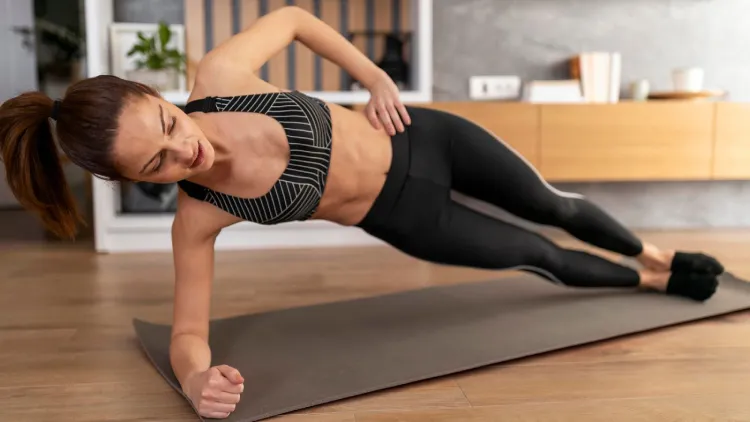
Advantages of Doing Side Planks
1. Enhanced Core Strength
Compared to most other core exercises, the side plank works the obliques, thereby creating rotational strength that becomes a vital factor in both normal day movement and athletic performance. It can be used in the prevention of lower back pain by training the muscles that support the spine.
2. Better Posture and Balance
The plank is beneficial because the stabilising muscles, which work to hold the spine straight, are tightened, and hence, this enhances posture and prevents the spine from going out of position. This will be able to improve balance and lessen stress on the hips and lower back.
3. Regular Waistline and Oblique Definition
Regular workouts can assist in slimming down the abdominal area and minimise fat in areas around the waist (with the right kind of diet and workouts). This is the direct contributor to a slim, tight and toned waist.
4. Injury Prevention
Having more core muscles, particularly the obliques and transverse abdominis, can help prevent lower injuries such as lower back pain or hip conditions that can occur to you. It is also beneficial to the health of joints and the maintenance of the spine during the moving activities.
5. Full-Body Stability
The side plank develops a more comprehensive level of body control, coordination, and confidence by simultaneously challenging multiple muscle groups. It is also capable of improving your sports performance, lifting and daily performance.
How to Master a Side Plank
Step-by-Step Instructions:
- Begin in the position of lying on your side, with legs stretched out and feet together.
- Your forearm should not be on the ground, but your bottom elbow should be under what you call your shoulder.
- Raise your hips off the floor, and form a straight line between the head and heels.
- Each workout uses your belly and buttocks, and does not keep your body filled.
- The challenge is to hold the position for 20 to 30 seconds while breathing continuously.
- Gradually get back to the initial position and change sides.
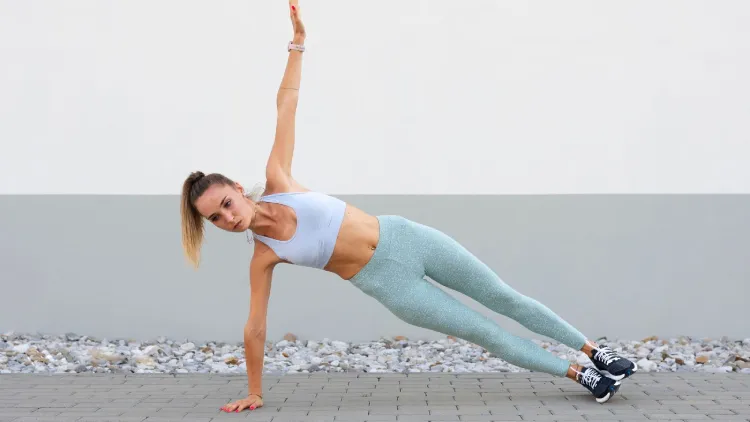
Side Plank Variations at Both Levels
1. Side Plank with Knees Bent
Use your knees and not your feet to support your body. Such variation decreases the load and is ideal for new exercisers or recently injured.
2. Side Plank Hip Dips
Raise and dip the hips as you are planking. This dynamic version comes with more involvement of the oblique as well as offers a toning effect.
3. Side Plank with Leg Raise
After balancing your position on the side plank, elevate your top leg and maintain its position. This adds activation to both the inner and outer thighs of the body, as well as a challenge of balance.
4. Star Plank
Behold, bring both the upper arm and leg, And make a star of thee. It is a sophisticated form of the product that enhances muscle activation and balance.
5. Side Plank Reach-Through
Rotate the body and place your top arm beneath the body, then go back to the plank. Fine in the working movement and tightness of the abdomen.
Most Popular Side Plank Errors to Avoid
- Dropping the Hips: Your core should be tight to avoid slacking.
- Shoulders misaligned: The shoulders are supposed to be positioned directly over the shoulder joint.
- Holding Breath: Continue inhaling to sustain endurance.
- Bend Forward or Back: Be on your side so that you are perfectly straight.
- Neck Strain: Do not strain or tilt your neck outwards to your spine.
Side Plank Workout Routine
You can add the plank to any core routine. Here’s a simple sequence:
| Exercise | Duration / Reps |
| Side Plank (Left) | 30–45 seconds |
| Side Plank (Right) | 30–45 seconds |
| Side Plank Hip Dips | 12–15 per side |
| Side Plank Leg Raise | 10 per side |
| Rest | 60 seconds |
| Repeat | 2–3 rounds |
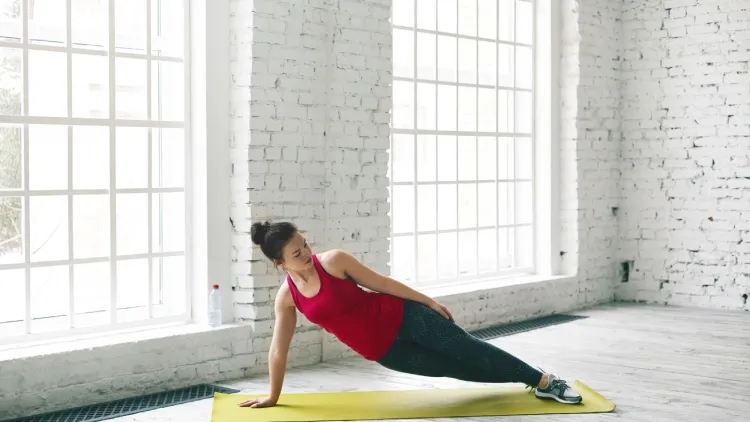
Who Should Do Side Planks?
The side plank unites different levels of fitness of a person: beginners and highly trained sportsmen.
It’s highly beneficial for:
- People with poor or poorly developed core muscles.
- Individuals with back pain and postural problems.
- Athlete to gain rotational and lateral strength.
- Anybody who wants to lose the fat in the middle or have a slimmer waist.
Nevertheless, planks are not recommended in case of a shoulder injury or a spinal injury, where you should seek the advice of a professional and adjust the posture to your requirements.
Benefits of Side Planks (Long-term)
With time, regular planking will result in a stronger core, improve back and spine stability, minimise posture imbalance, and strengthen deep core muscles that are ignored by most individuals. With the core strengthening, you will observe an improvement in your walking, running, lifting and even breathing.
The side plank is not just an exercise to work your abs; it is a core exercise with effects that spread to the whole body.

Final Thoughts
The side plank is an effective, versatile, and accessible exercise for every individual who is aiming at achieving a stronger core, gaining more stability, and a leaner waist. This exercise fits several programs, such as reducing belly fat, slimming the waist, and better posture, and even athletic performance.
It is wise to begin simple and stick with it until you master the movement, and then, when you do, stick to complex forms. It will do your body (and your fundamental soundness) a favour.
Frequently Asked Questions
1. What is the frequency of side planks?
Depending on your fitness levels, you are able to do side planks 3-5 times per week. Slipping in a plank even 30- 60 seconds a day can bring significant results in core strength and waist shape in several weeks.
2. Is a side plank an improvement on a regular plank?
The side plank is more intense and affects the obliques and the lateral stabilisers more, which makes it superior to the side plank in the sense that it is an exercise that builds a balanced core and is good at making the waist slimmer.
3. Will belly fat be reduced when the side plank is used?
As much as the side planks tighten the belly and core muscles, belly fat is lost best through exercise, cardio and a healthy diet. Nevertheless, they are capable of assisting in forming and shaping your midsection when the general body fat is decreased.
4. What is the duration of a side plank?
Starting with 20-30 seconds per side, beginners can apply time and again till they can skip the seconds to 1 minute and beyond as the body gets accustomed.
